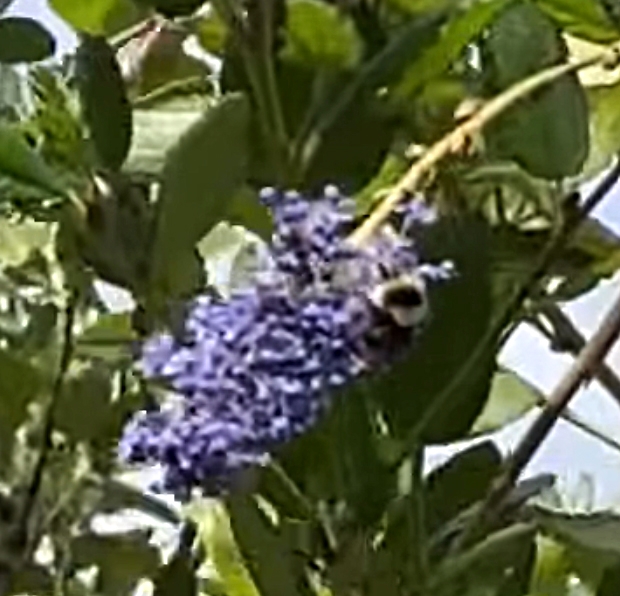
The contest, sponsored by the Bohart Museum of Entomology memorializes Thorp (1933-2019), a UC Davis distinguished emeritus professor and global expert on bumble bees who always looked forward to seeing the first bumble bee of the year.
De Grassi captured a video of a black-tailed bumble bee, Bombus melanopygus, foraging on a prized ceanothus plant on Sunday afternoon, Jan. 8 in her backyard in Davis.
She recorded the video on her cell phone at 12:32 p.m. to win the contest, sponsored by the Bohart Museum of Entomology and memorializing global bee expert Robbin Thorp (1933-2019), a distinguished emeritus professor of entomology. (See her YouTube video)
De Grassi, a former director of federal policy, livestock, animal health and welfare for the California Farm Bureau Federation, credits the storm, the UC Davis Arboretum and Public Garden, and her working relationships with bee scientists, including Thorp, as having a hand in either her find and/or her interest in plants and pollinators.
The three previous winners (2022 was a tie) each photographed a bumble bee in the 100-acre UC Davis Arboretum. Ironically, de Grassi bought her prized ceanothus at an Arboretum plant sale.
“I was doing clean-up in my backyard after Saturday night's rain and a 50-plus mile-per-hour windstorm,” said de Grassi, now an agricultural policy consultant. “The wind had subsided to a breeze by then. As I walked past my Ray Hartman ceanothus—which I purchased from a UC Davis Arboretum plant sale years ago when I did a garden makeover to be pollinator-friendly—I noticed some extra-long ceanothus branches that needed to be pruned, including some with super-early blooming flowers.”
De Grassi returned with her pole trimmer and started cutting. It was then she noticed a bumble bee foraging on her ceanothus--and when she remembered the “friendly Bohart Museum contest” inviting folks to find and photograph the first bumble bee in the two-county area of Solano and Yolo.
“I fumbled to retrieve my cell phone from my pocket to record, just to get in on the fun,” said de Grassi. “These bumbles dart around a lot, they don't stay put for photo ops.”
De Grassi knew Thorp from her professional work with the California Farm Bureau Federation and from her friendship with bee scientists Timothy Lawrence and Susan Cobey, formerly of UC Davis. “Tim and Sue were active in the California Farm Bureau's statewide Bee Advisory Committee that I managed,” she said. Lawrence is now a Washington State University Extension county director (Island County) and Cobey, a WSU bee breeder geneticist.
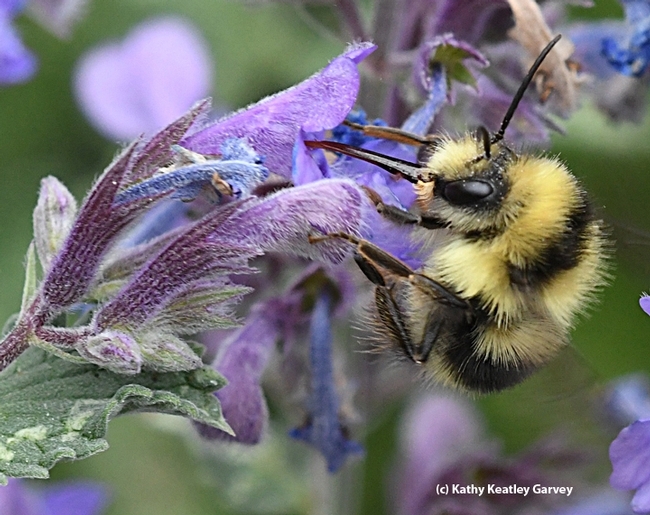
“I love documenting nature's cool stuff and especially the surprises we uncover when we pause long enough to notice,” de Grassi commented. The caterpillars she discovered eating her coral fountain (aka “firecracker plant,” Russelia equisetiiformis) led to UC Davis distinguished professor Art Shapiro documenting it as a butterfly larval host.
“Gardening for pollinators has become my passion pastime. I like to give native and managed bees pesticide-free forage.”
As her prizes, de Grassi received a Franklin's bumble bee coffee cup from the Bohart Museum and handmade bee gifts (including a zippered bee-motif bag and bee-motif soaps) from Teresa Hickman of Vacaville, owner of "Handmade by Teresa."
De Grassi holds two degrees from UC Davis: a bachelor's degree in agricultural science and management and a master's degree in animal science. She is a former chair of the UC Davis Department of Animal Science Development Board, and a former member of the Cal Aggie Alumni Association Board and the UC Davis Foundation Board of Trustees.
The Davis resident is no stranger to the UC Davis Arboretum (site of the previous winners). “I've walked the Arboretum since the time I was an undergrad here. It's my favorite place on campus and was absolutely my inspiration for plant choices in my urban garden makeover.”
Postdoctoral researcher Charlie Casey Nicholson of the Neal Williams lab and the Elina Lastro Niño lab, UC Davis Department of Entomology and Nematology, won the 2021 contest by photographing a B. melanopygus at 3:10 p.m., Jan. 14 in a manzanita patch in the Arboretum.
UC Davis doctoral candidate Maureen Page of the Neal Williams lab and horticulturist Ellen Zagory, retired director of public horticulture for the UC Davis Arboretum and Public Garden, tied for first in the 2022 contest by each photographing a bumble bee foraging on manzanita (Arctostaphylos) in the Arboretum at 2:30 p.m., Saturday, Jan. 1.
Page, who now holds a doctorate in entomology, photographed a B. melanopygus, while Zagory captured an image of the yellow-faced bumble bee, B. vosnesenskii.
Thorp, a 30-year member of the UC Davis faculty, and a tireless advocate of pollinator species protection and conservation, retired in 1994, but he continued working until several weeks before his death on June 7, 2019 at age 85. In 2014, he co-authored two books: Bumble Bees of North America: An Identification Guide (Princeton University,) and California Bees and Blooms: A Guide for Gardeners and Naturalists (Heyday).
Attached Images:
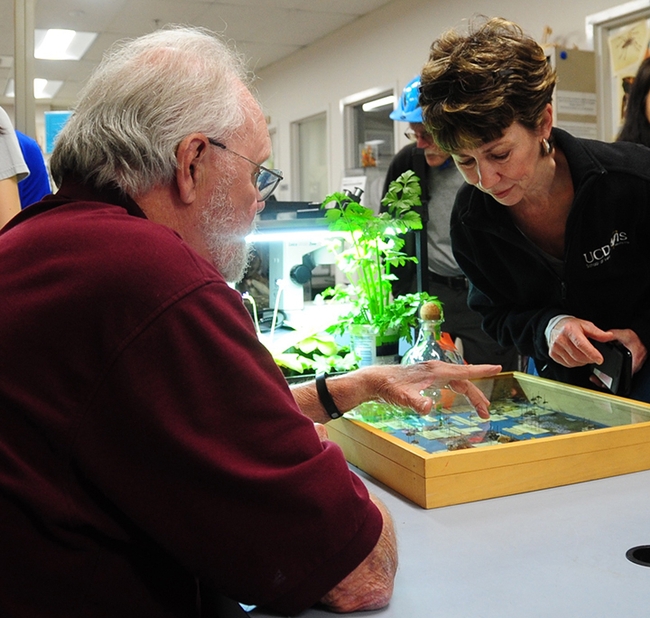
Pollinator enthusiast Ria de Grassi of Davis confers with UC Davis distinguished emeritus professor Robbin Thorp (1933-2019) at a Bohart Museum of Entomology open house in 2017. (Photo by Kathy Keatley Garvey)
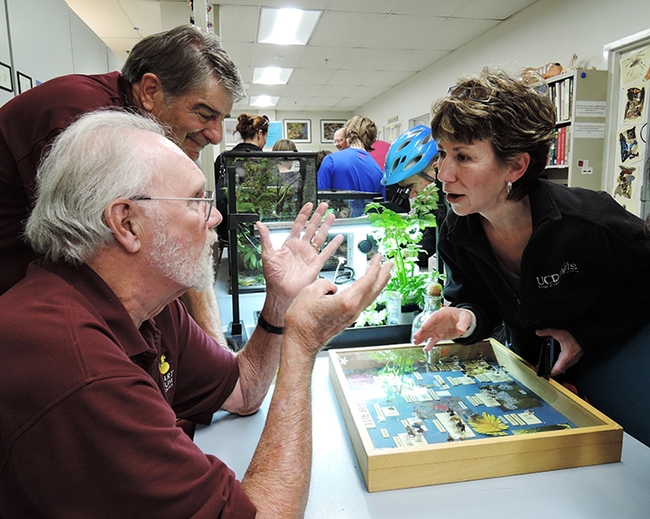
UC Davis distinguished emeritus professor Robbin Thorp (1933-2019) discusses with Ria de Grassi the unusual carpenter bee she found. (Photo by Kathy Keatley Garvey)
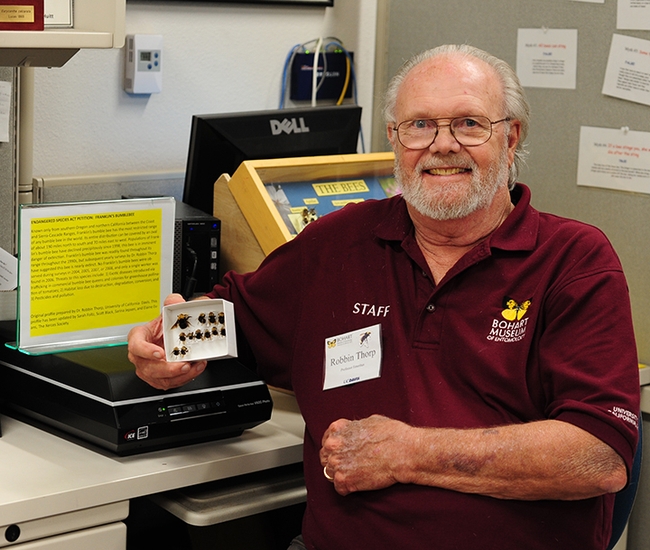
UC Davis distinguished emeritus professor Robbin Thorp (1933-2019) answers questions at a 2017 Bohart Museum of Entomology open house. (Photo by Kathy Keatley Garvey)
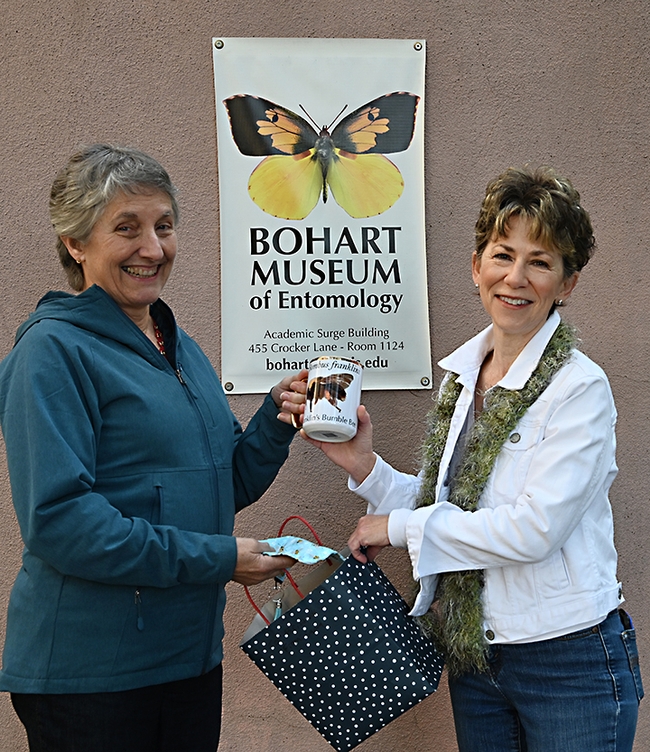
Lynn Kimsey (left), director of the Bohart Museum of Entomology, presents a prized coffee cup with an image of Franklin's bumble bee to Ria de Grassi. (Photo by Kathy Keatley Garvey)